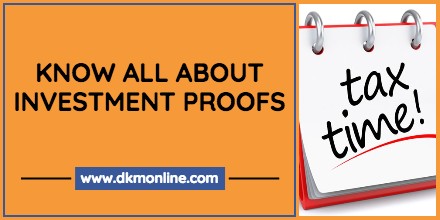Do you remember a situation where yours ears widened hearing the word Income tax?
Well I believe the answer is yes. Many of us can relate ourselves to such situations. Income tax and deductions are very important for salaried people. We often plan our Income tax for the coming assessment year before the beginning of the year itself.
As the accounts are to be closed by 31st March 2017 and a new beginning would call for a wise investment plan. So as the tax time is approaching, let us start grabbing some knowledge about investment alternatives, tax deductions and also the investment proofs required for the same. At DKM Online we always insist employees and our clients who have outsourced their payroll management to us, that it is recommended to keep the investment proofs organized.
Why do we need to submit Investment Proofs to our employer?
The finance Act 2015 has introduced section 192(2D), wherein the person responsible for payment of salary (employer) is obliged to collect the necessary evidence or investment proof in the prescribed manner to allow any claim or deduction to the assessee, an employee in the case of salaried people.
Every employer needs to deduct TDS on employee’s salary paid by the employer every month and submit it to the government authorities by 7th of the following month. As and when the employer specifies employee’s CTC, the employer would ask for our provisional investment plans and the supporting documents, so that he may deduct the TDS accordingly. The employee needs to submit these investment proofs by the year end to the employer.
Investment Proofs (and underlying documents) required for Tax Deductions:
For Deductions Under Section 80C
They are many instruments under which investments can be made. Some specified investments with their investment proof documents are:-
- Public Provident Fund Account: The investment proof required to claim deductions under PPF account are, Copy of Bank statement for amount paid towards PPF and Copy of stamped deposit receipt.
- Tax Saving Fixed Deposit: Investment Proof for tax saving FD would be Copy of Fixed Deposit receipt invested in the current year.
- Tax Saving Mutual Fund: In case of a tax saving mutual fund the copy of Investment certificate for investments made for current year can be submitted as an investment proof.
- National Savings certificate: You can submit a copy of the NSC certificate in the name of assessee himself as a proof of investment in NSC.
- Premium on Life Insurance Policy: Premium receipts in the name of self, spouse and children are the approved proofs of investment by the income tax department for claiming tax deductions.
Contribution Pension Funds Under Section 80CCC & 80CCD
- Contribution to Pension Funds: Valid investment proof includes, Receipts received for premium paid during the current year.
- Contribution to National Pension Schemes: Receipts received for premium paid during the current year can be the investment proof
Deduction for Investment made under An Equity Linked Saving Scheme (ELSS)
This deduction is allowed to the extent of 50% of the amount of investment which is made in listed shares and mutual funds. The document required as an investment proof is a Copy of Form A submitted with Depository participant.
Deduction for Interest on Savings Bank Account
A deduction of Rs. 10,000 can be claimed for interest earned on Savings Bank Account. A copy of bank passbook with interest entries can be shown as the proof of investment.
Deduction for Home Loan and Interest
If the Assessee has taken any home loan he may claim a deduction of the principal amount paid to bank as well as for interest. The assessee needs to submit a Loan Interest Certificate stating the amount of loan, monthly installment and the interest charged as the investment proof in case of home loan and interest.
Deduction for Medical Insurance and Health Check-ups
An assessee may claim a deduction for the premium paid towards Medical insurance taken by the assessee for self, spouse, and children, and as well for the amount paid towards preventive health check ups. For which the assessee needs to provide the Insurance proofs and recepits of premium paid and medical bills.
These are the various tax deductible investments and expenses with their underlying documentation. An assessee should always plan his CTC in order to reduce his tax burden and take use of benefits provided under the Income Tax Act, 1961.
Stay tuned for the next blog in the series of Investment Proofs. For any further details, feel free to contact us.

